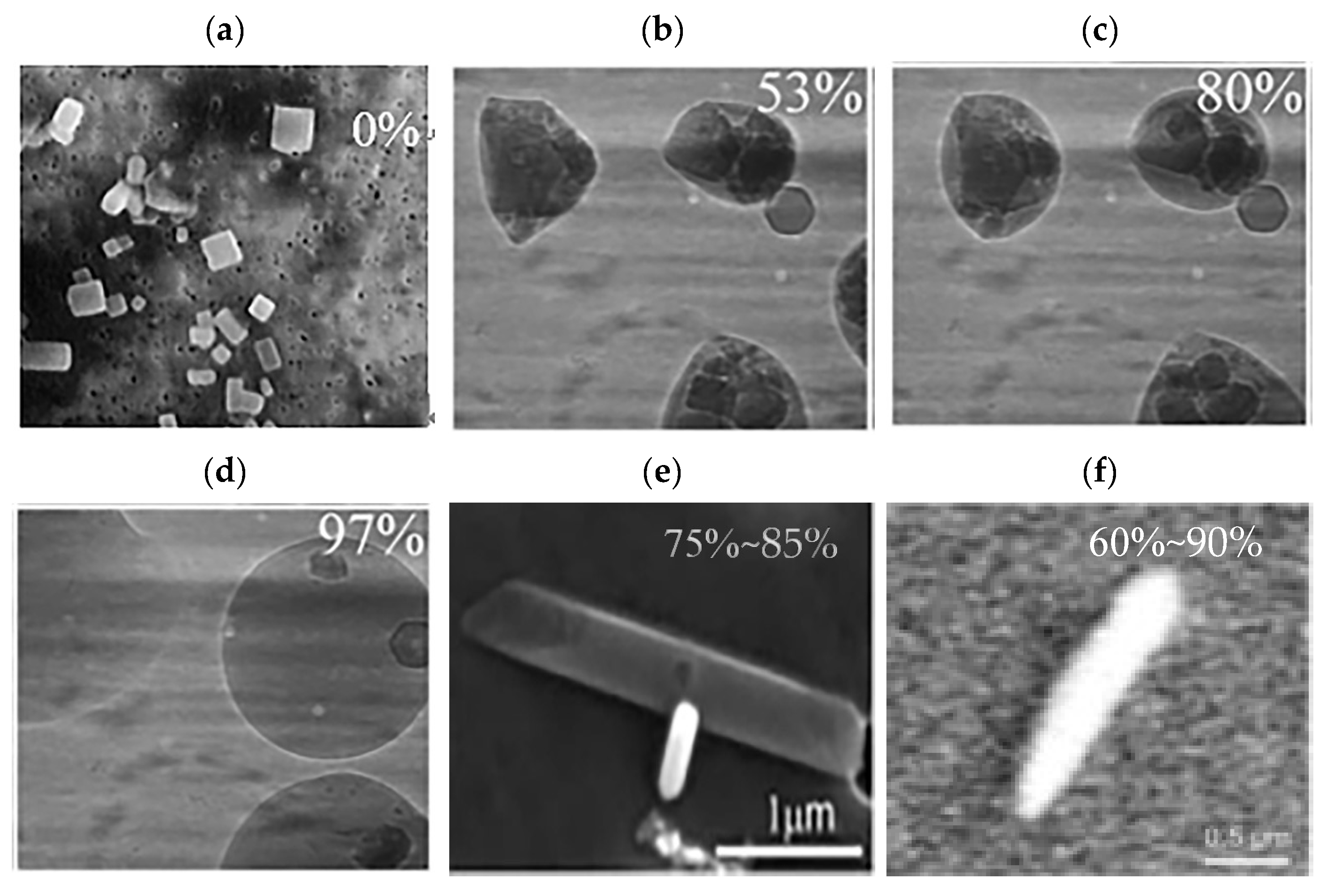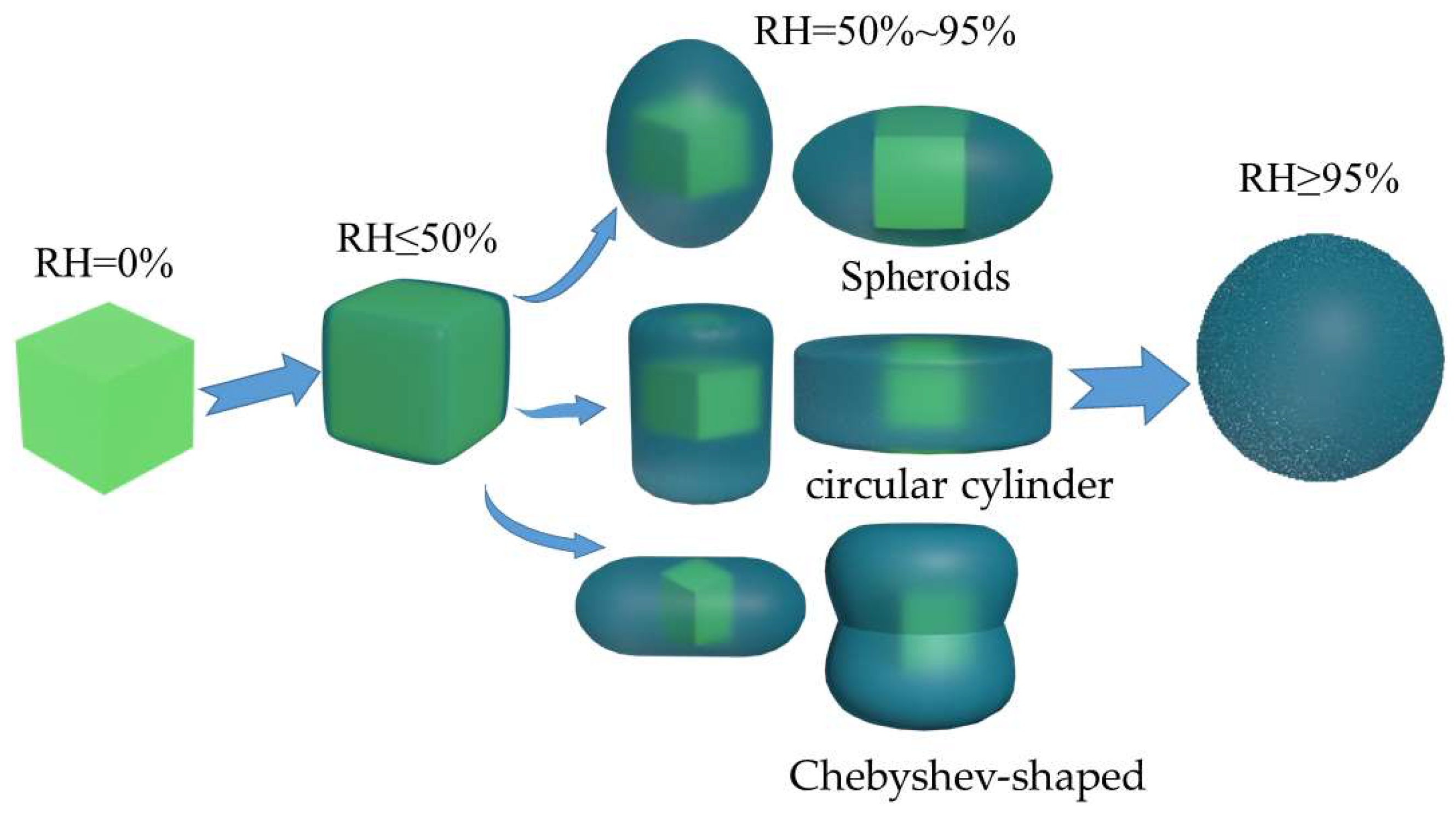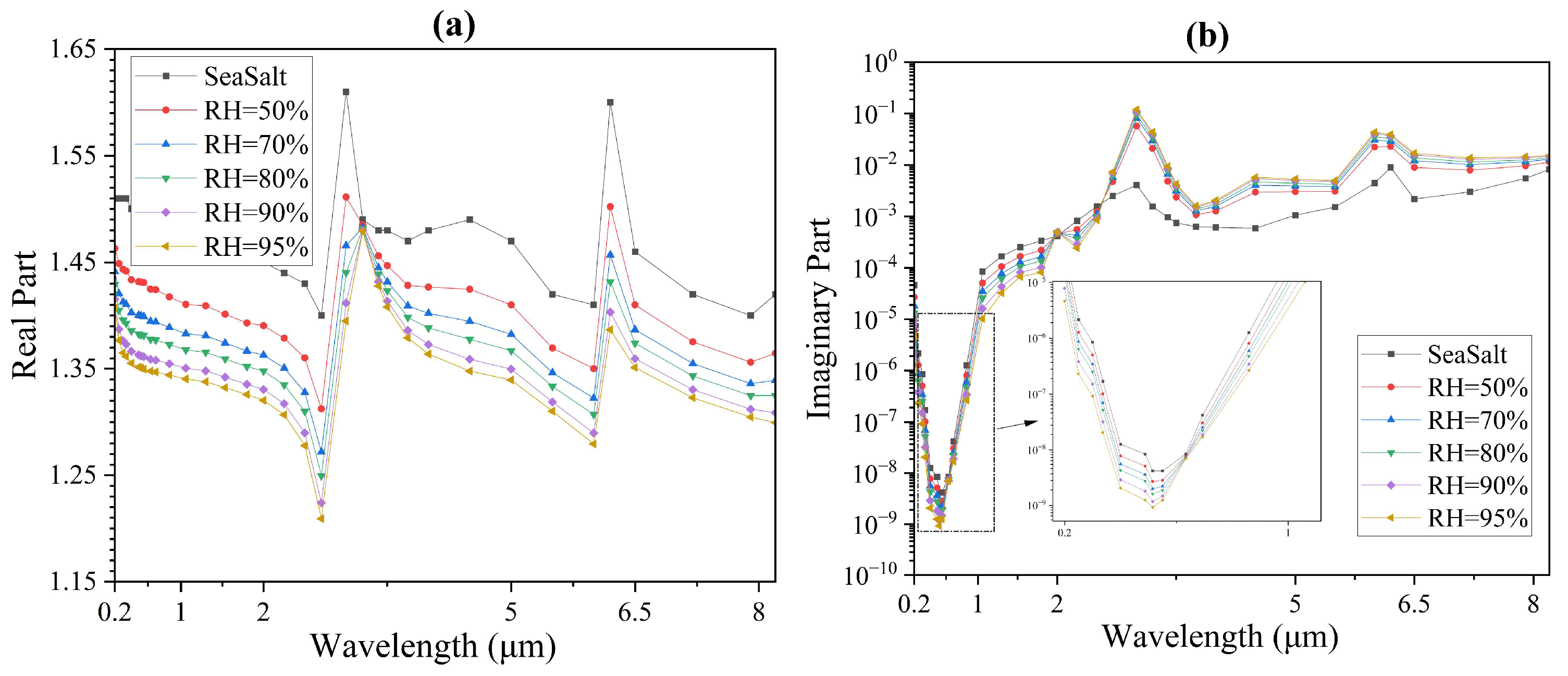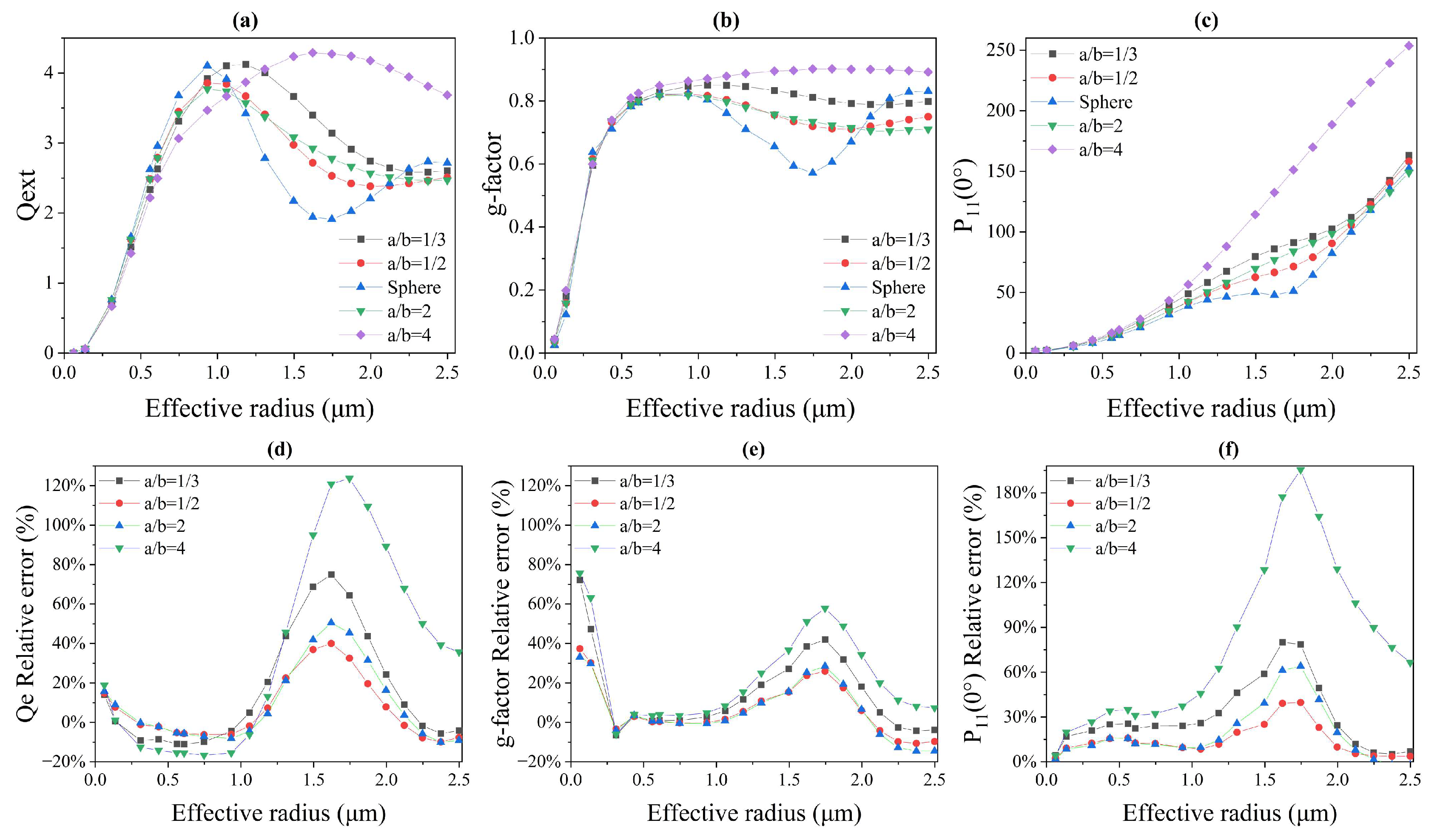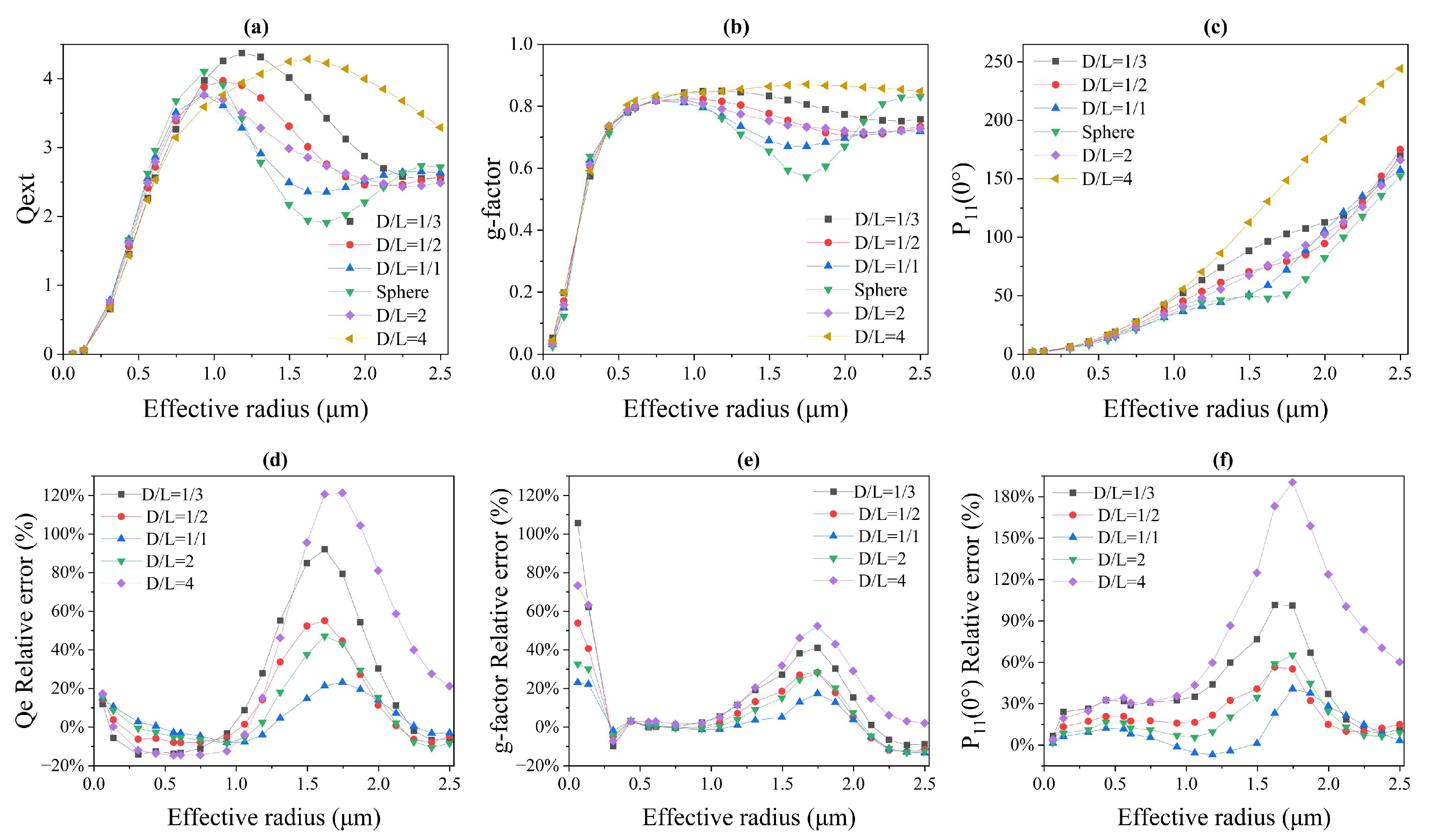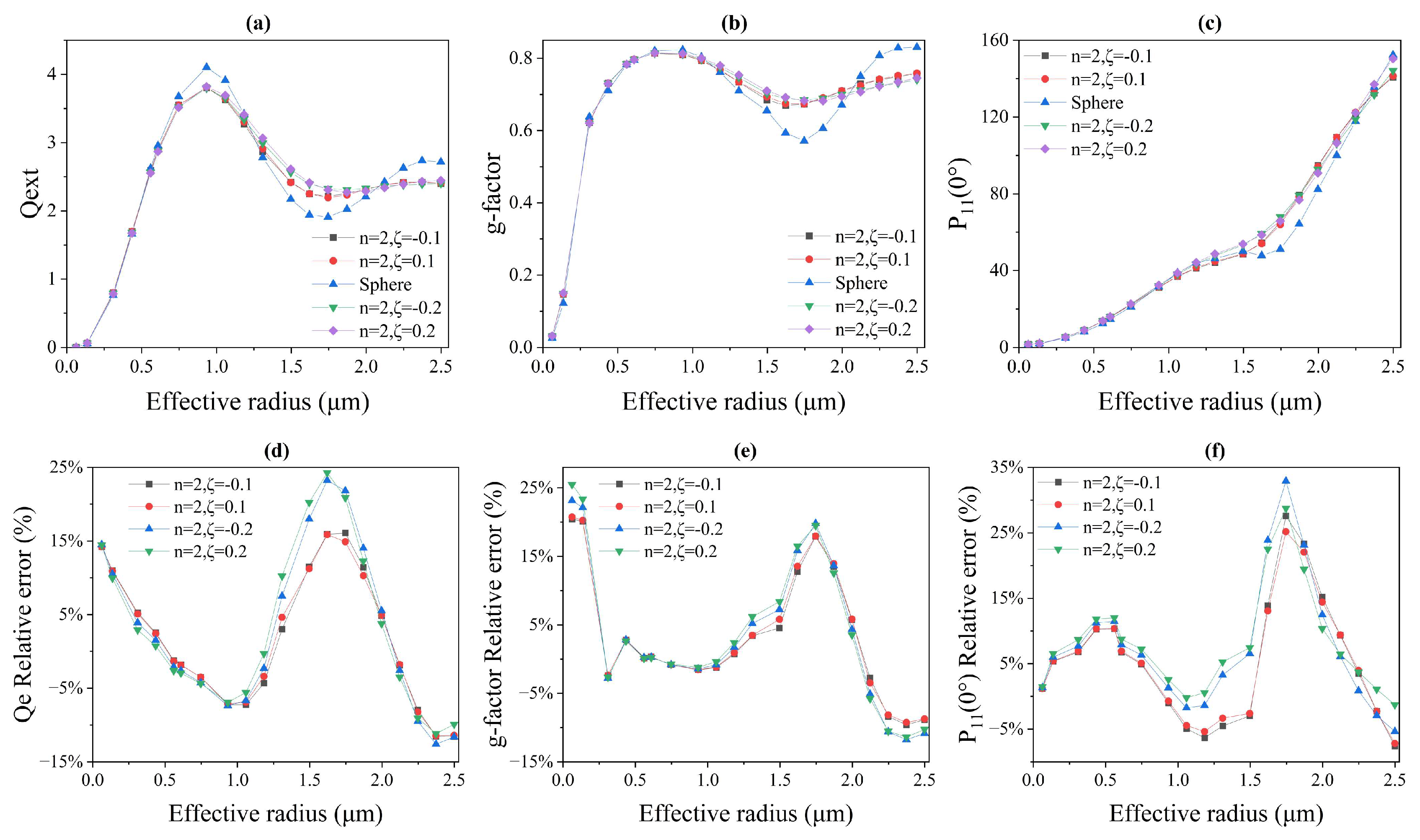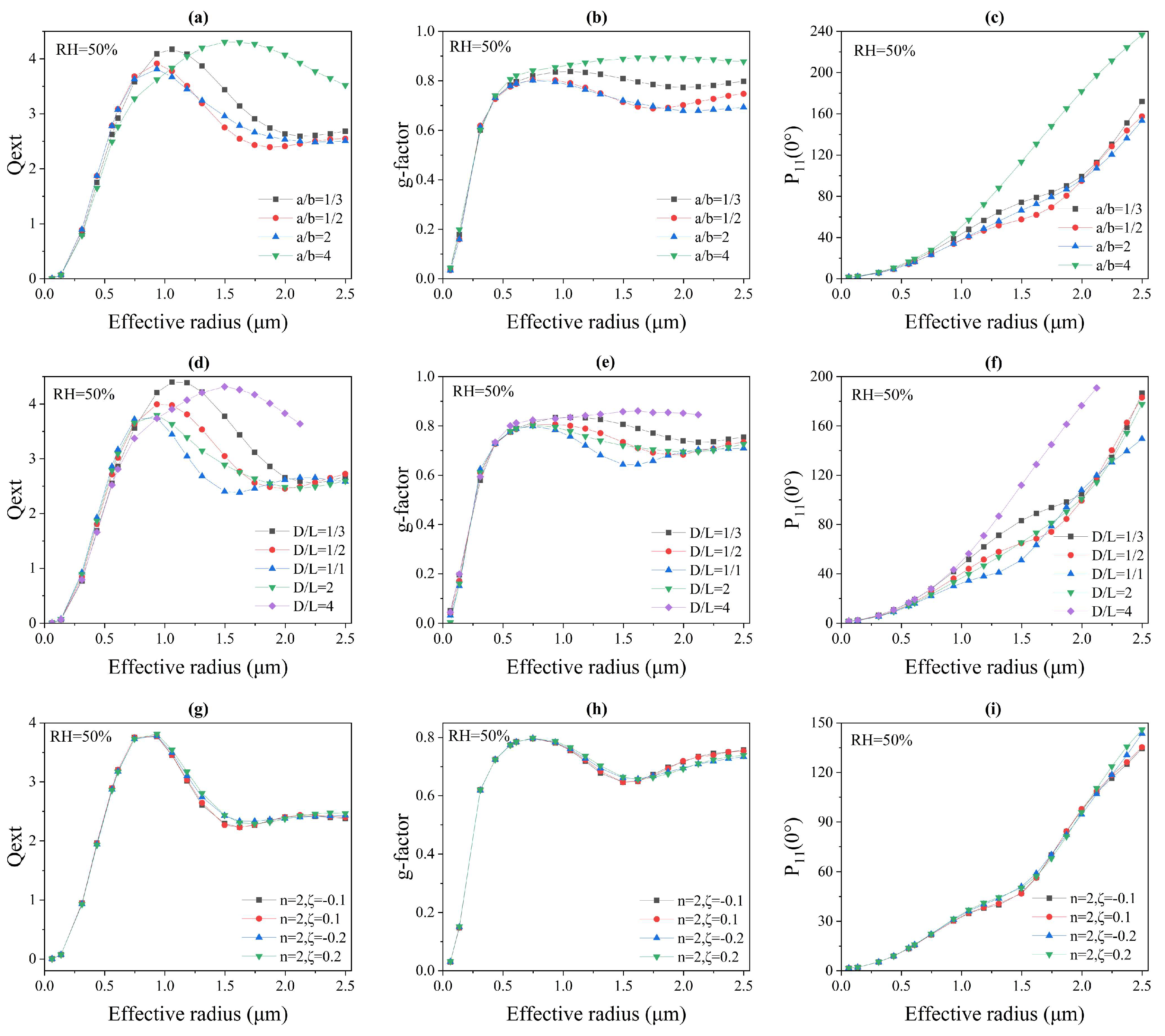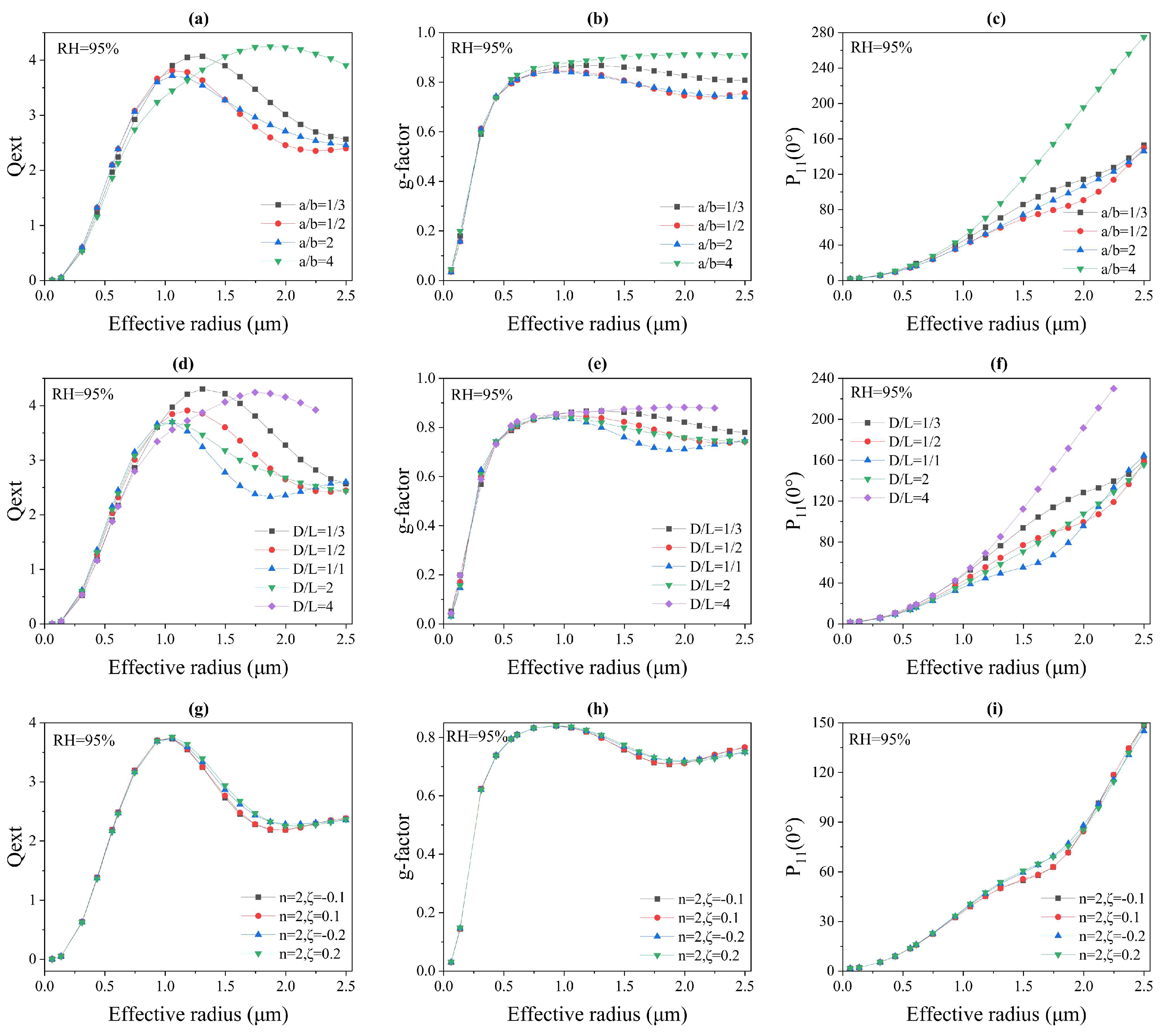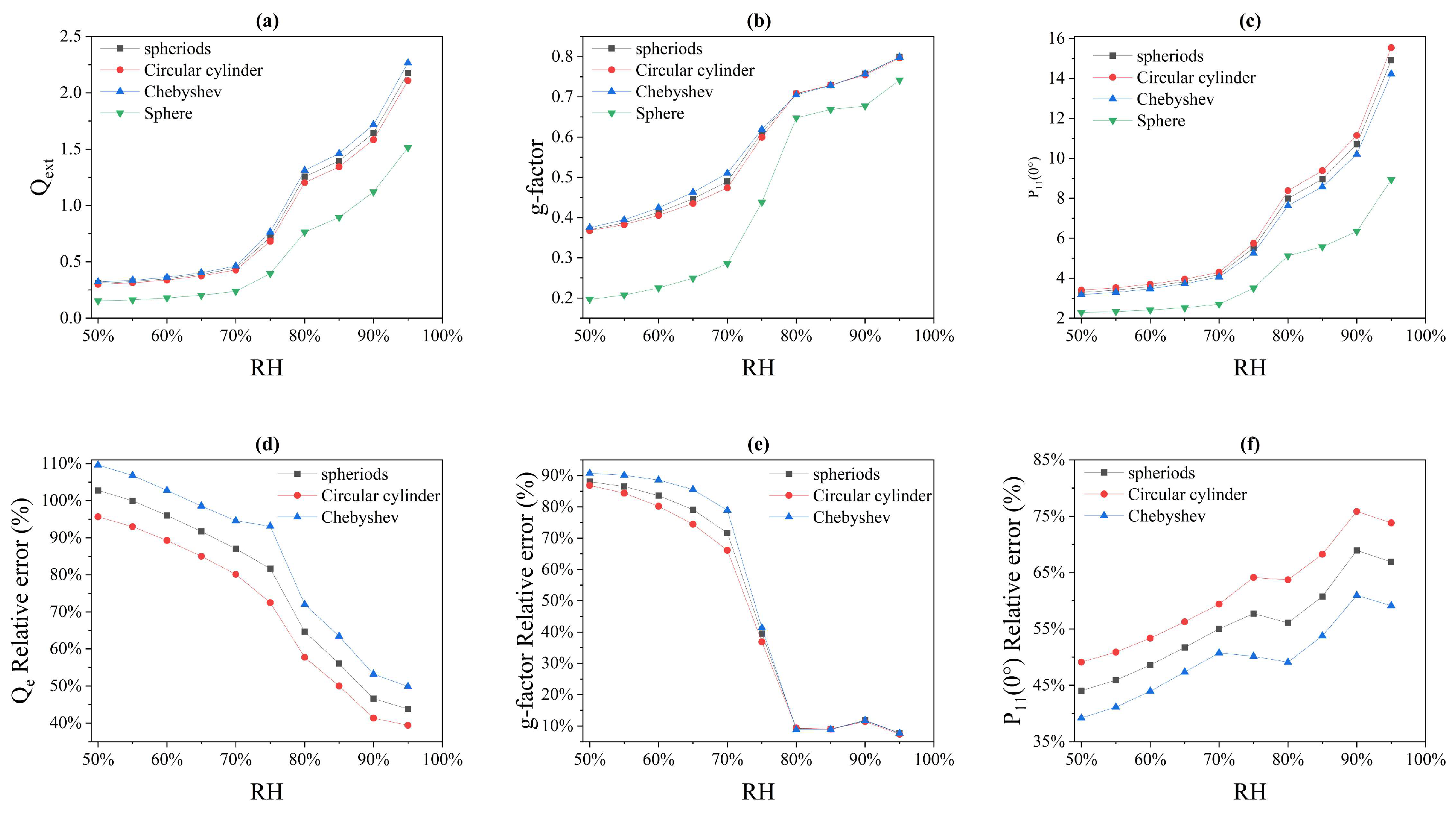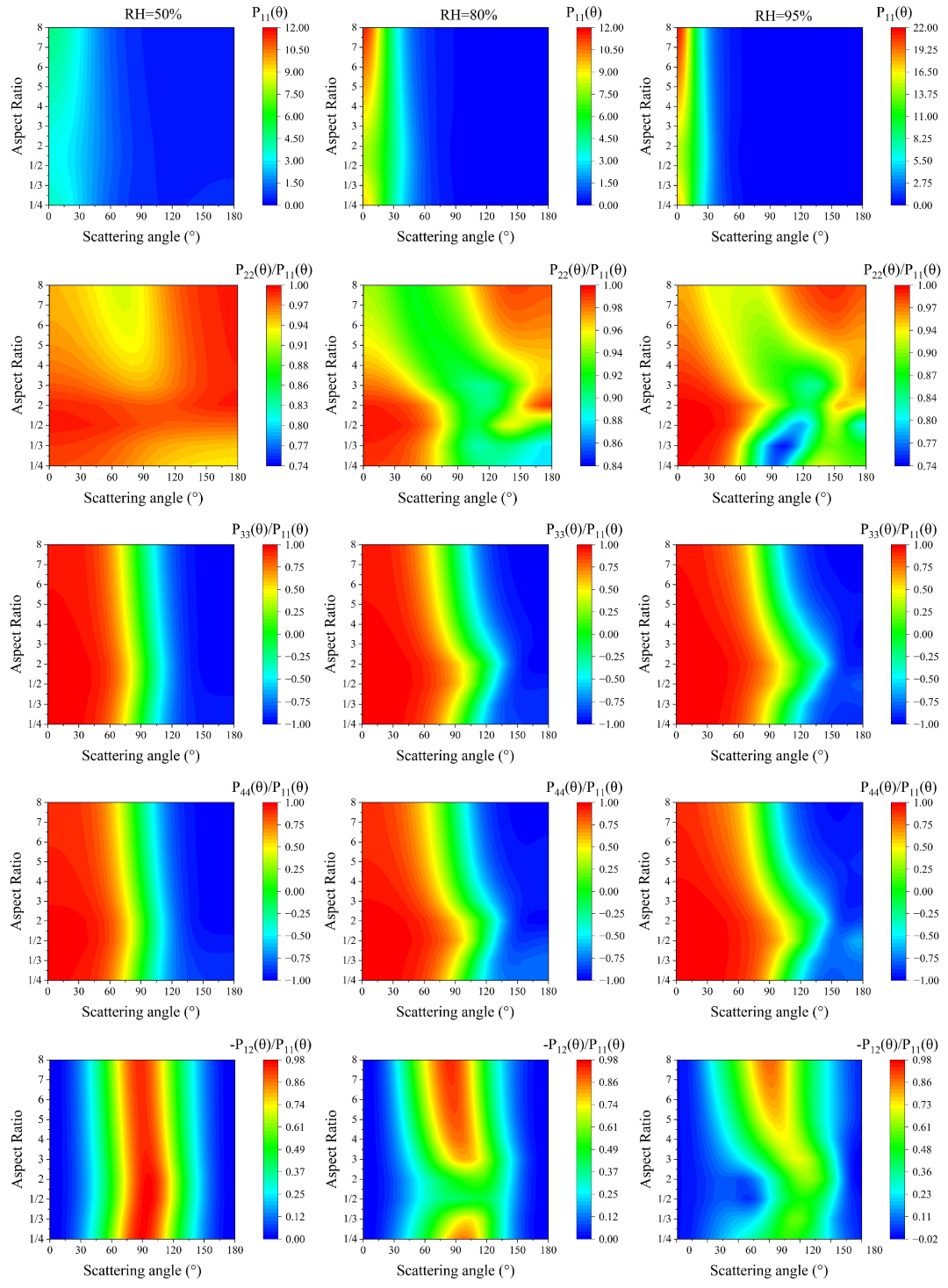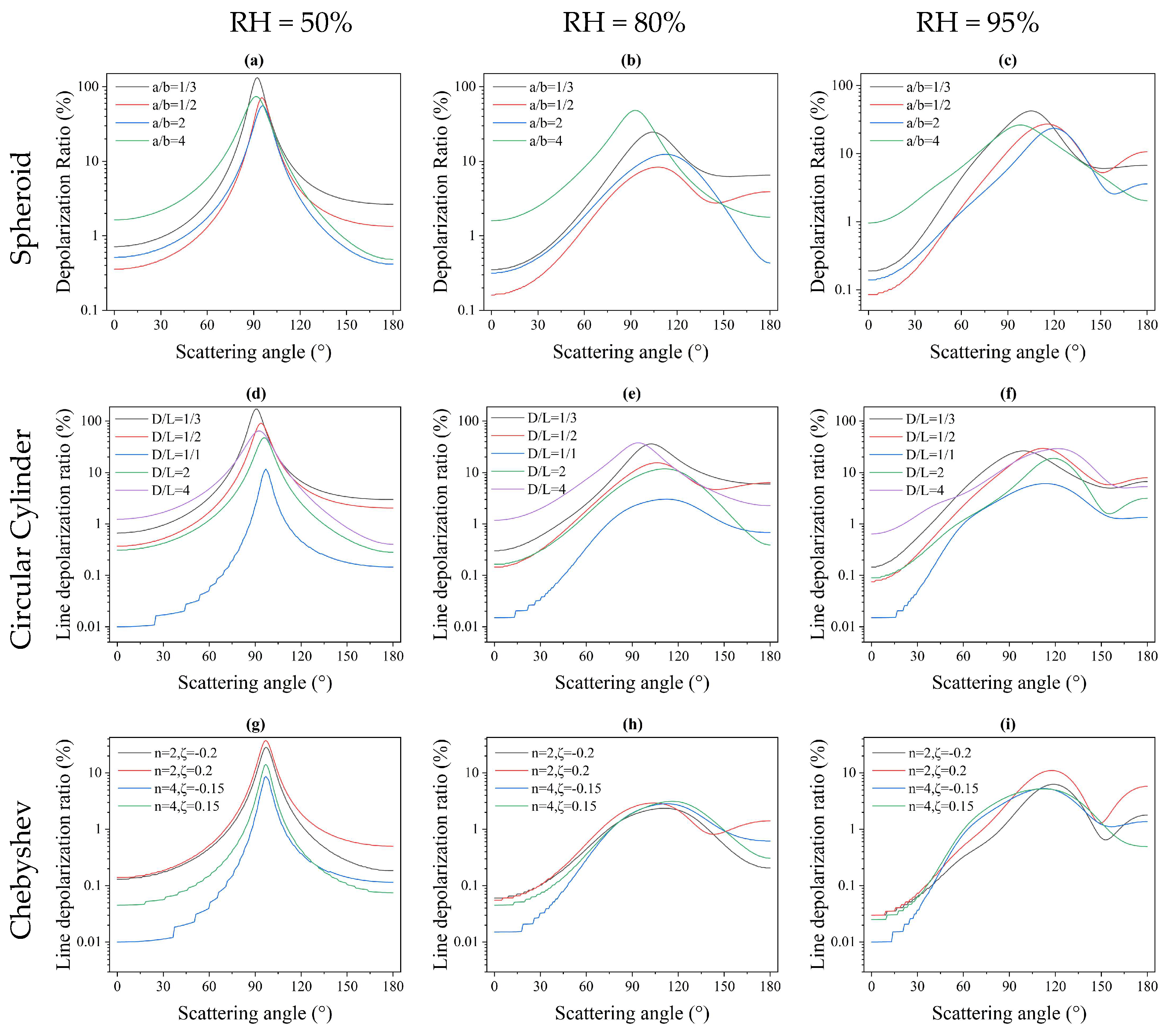1. Introduction
Sea salt aerosol is the largest natural contributor to atmospheric particulate matter on a global scale [
1,
2,
3], playing a pivotal role in near-surface atmospheric visibility, cloud and fog formation, biogeochemical cycling, the Earth’s radiation balance, as well as in remote-sensing observations, environmental monitoring, and other research endeavors. The scattering of solar radiation significantly influences the microphysical properties of sea salt aerosols and the albedo of marine clouds, underscoring the need for a comprehensive understanding and quantification of the scattering properties of these non-spherical particles. Understanding and quantifying the impact of sea salt aerosols is essential due to their far-reaching effects on atmospheric, environmental, and climate-related factors [
4].
Sea salt aerosol particles exhibit a broad spectrum of particle sizes. Specifically, particles with a diameter of less than 1 μm are considered small sea salt aerosol particles, those ranging from more than 1 μm to less than 25 μm are categorized as medium-sized sea salt aerosol particles, and those exceeding 25 μm fall into the category of large sea salt aerosol particles [
4,
5]. In 1956, Junge introduced a classification system for marine aerosols, dividing them into two modes: the submicron mode (0.1~1 μm) and the coarse mode (>1 μm). Within the submicron mode, further subdivision can be made into three categories: the Aitken mode (<0.2 μm), the accumulation mode (0.3~0.4 μm), and the coarse mode (>0.5 μm). This classification scheme encompasses three distinct categories of sea salt aerosols [
4,
5,
6]. Therefore, sea salt aerosol particles can be classified into three distinct categories. Throughout the aging process, sea salt aerosol particles undergo ion scavenging and oxidation of organic matter, resulting in significant alterations in water absorption, particle size, and particle morphology [
7].
Regarding the optical scattering characteristics of sea salt aerosol particles, the majority of previous research has primarily addressed the morphological attributes of sea salt aerosol particles within idealized environmental settings. Specifically, these conditions encompass scenarios where sea salt aerosol particles assume a cubic configuration under lower humidity levels or a spherical configuration under elevated humidity levels. However, in real scenarios characterized by the multifaceted nature of the marine environment, the morphological features of sea salt aerosol particles exhibit notable diversity [
8,
9,
10,
11]. Previous literature reports have observed various non-spherical sea salt particles with different aspect ratios through scanning electron microscope (SEM) images. Freney and others have found that atmospheric aerosol particles exhibit different characteristics in different humidity environments, and the influence of shape on optical properties varies with humidity [
12,
13]. The morphology of sea salt aerosol particles is dependent on the humidity level. At low humidity, these particles take on a cubic shape. However, when the humidity exceeds 50%, the sea salt aerosol particles transform into wrapped nuclei granular droplets and are influenced by factors such as sea breeze, pressure, and gravity. As a result, the morphology of these particles adopts various forms, including spheroid and oblong circular cylinders, characterized by different aspect ratios [
12,
13,
14,
15]. The morphology of sea salt aerosol particles exhibits spheroid and elongated circular cylinders with varying aspect ratios, making it a topic of considerable research interest. Investigating and analyzing the optical scattering characteristics of these aerosols with different morphologies at varying relative humidity (RH) levels through the use of generation mechanisms and theoretical simulations [
13,
16,
17,
18,
19,
20] has emerged as a current and prominent area of research.
Previous studies have revealed that utilizing a spherical model to simulate the optical scattering properties of sea salt aerosol particles results in significant errors [
21,
22,
23]. The findings of this investigation are succinctly presented in the subsequent table. As noted earlier, it is important to acknowledge that the morphology of sea salt aerosol particles is not invariably cubic. In a multitude of scanning electron microscopy (SEM) images documented in existing literature, there is evidence of variable aspect ratios and roundness [
21,
23]. The majority of contemporary research has employed spherical models [
21,
24,
25,
26,
27] and cubic models [
21,
22,
24,
27,
28,
29] to model sea salt aerosol particles. Research has demonstrated that spherical models, under ideal conditions, fail to accurately depict the optical properties of sea salt aerosols in real-world scenarios, the impact of the morphological factors of sea salt aerosols in studies is significant and cannot be overlooked, and the change in the morphology of hygroscopic sea salt aerosols, combined with humidity conditions, also affects studies on optical scattering properties. Elongated and flattened rectangular models [
24], as well as superellipsoids [
30,
31], have also been used to model homogenous sea salt aerosol particles, emphasizing the importance of aspect ratios and roughness in studies of the linear depolarization ratio (LDR) of sea salt aerosol particles, and have explored the impact of relative humidity on the linear depolarization ratio of moist sea salt. Spherical and superspheroidal shapes generally represent dissolved sea salt, while cubic and rectangular shapes represent dry sea salt.
In typical oceanic climatic conditions, the average relative humidity (RH) stands at approximately 75% or higher, and historical records from 1991 to 1994 indicate an average of around 80%. However, it is noteworthy that within the global atmosphere, lower RH levels (below 50–60%) are encountered intermittently. A measurement campaign was conducted between 23 January and 29 January 2002 at atmospheric research stations situated in proximity to Cannae on the western coast of Ireland (53°19′N, 9°54′W) and at Mace Head (GAW) on the eastern periphery of the North Atlantic Ocean. Throughout this period, the ambient RH exhibited fluctuations ranging from 51.6% to 96.1%, while the prevailing RH of the marine environment generally fell within this range [
32]. The RH of the marine environment typically falls within this range. Notably, variations in morphology among different models at distinct humidity levels can result in substantial disparities in the calculation of optical scattering properties. Bi et al. [
16] employed a superellipsoids model for sea salt aerosol particles and conducted an analysis of the optical scattering characteristics of these particles under diverse humidity conditions and non-spherical shapes. Their findings underscored the significant influence of aspect ratios, circularity parameters, and humidity on these properties. Michael Kahnert et al. [
9,
30] examined three non-ideal cubic and octahedral model geometries to simulate real scenarios of sea salt aerosol particles. They also investigated the use of super periods shape as a model to simulate the linear backscattering depolarization ratio and the extinction to backscattering ratio. Their findings [
8,
9,
30] show that this model shape exhibits significant differences in the depolarization ratio of sea salt aerosol particles. Moreover, discrepancies in the refractive index of sea salt aerosol particles among the models also affect the analysis of optical properties. Understanding the impact of RH on the optical scattering characteristics of sea salt aerosol particles is crucial for practical applications in various scenarios.
Atmospheric aerosols can significantly influence the transmission of laser signals. Within the realm of investigating the optical scattering characteristics of non-spherical sea salt aerosol particles, the predominant focus has centered on wavelengths of 0.55 μm, 0.532 μm, and 0.7 μm [
8,
9,
16,
21,
30,
32]. In addition to the previously mentioned wavelengths, the 1.06 μm laser wavelength is the most commonly used. This wavelength is situated in the atmospheric window, where the impact of atmospheric molecules in terms of absorption and scattering is minimal compared to aerosol attenuation near the ground. When it comes to the 1.06 μm laser, the primary influence of the atmosphere is the scattering caused by aerosol particles [
33,
34,
35]. Therefore, the 1.06 μm laser has been a major research focus in the field of atmospheric aerosol optical scattering. It is also widely utilized in the ocean. This paper aims to investigate the scattering characteristics of three distinct morphologies of sea salt aerosol particles under different humidity conditions, taking into account their varying deformation parameters. To achieve this, the T-matrix method is employed to numerically calculate these characteristics. The findings of this study offer valuable insights into the transmission properties of the 1.06 μm infrared laser in atmospheric aerosols.
This paper follows the following organizational framework:
1. Part 2 develops a physical-chemical model of sea salt aerosol particles, establishing various morphological and complex refractive index models for sea salt aerosol particles at different humidity levels.
2. Part 3 introduces the T-matrix calculation method theory that is utilized in this study.
3. Part 4 employs the T-matrix method to calculate the light-scattering characteristics of non-spherical sea salt aerosol particles with varying shapes, aspect ratios, and morphology parameters. It also analyzes the distribution of polarization characteristics at different scattering angles for different humidity levels and aspect ratios.
4. Part 5 summarizes the conclusions drawn from this paper.
2. Microphysical Properties of Sea Salt Aerosol Particles
2.1. Particle Morphology Modeling of Sea Salt Aerosol Particles
Figure 1 illustrates the morphology of sea salt aerosol particles at varying RH levels. The figure reveals that under dry conditions, the sea salt aerosol particles exhibit a cube or rectangular shape, along with other columnar morphologies. However, as the RH surpasses 50%, the morphology of the sea salt aerosol particles approximates a spheroid or circular cylinder, resembling rotationally symmetric Chebyshev-shaped particles. It is important to note that these spheroidal, circular cylindrical, and rotationally symmetric particles share a common morphology [
12,
15,
16,
33,
34,
35]. These spheroidal, circular cylindrical, and other various shapes have differing aspect ratios.
Figure 1 presents the morphologies of sea salt aerosol particles under different conditions: (a) showcases the morphology of dry sea salt aerosol particles, while (b) exhibits the morphology at RH = 53%. Similarly, (c) illustrates the morphology at RH = 80%, (d) represents the morphology of sea salt aerosol particles at RH = 97%. In addition, (e) and (f) display an approximate long circular cylinder for sea salt aerosol particles at RH is 75~85% and 60~90%, respectively [
14,
35]. Specifically, (a) showcases the morphology of dry sea salt aerosol particles, while (b) exhibits the morphology at RH = 53%. Similarly, (c) illustrates the morphology at RH = 80%, (d) represents the morphology of sea salt aerosol particles at RH = 97%. In addition, (e) and (f) display an approximate long circular cylinder for sea salt aerosol particles at RH is 75~85% and 60~90%, respectively.
As depicted in
Figure 1, sea salt aerosol particles display varying morphologies based on humidity conditions. In the RH range of 50~80%, these particles commonly exhibit a circular cylinder primarily due to moisture absorption and dissolution processes. Additionally, they demonstrate a Chebyshev-shaped particle characterized by rotational symmetry. On the contrary, when the RH exceeds 80% and approaches 95%, sea salt aerosol particles predominantly assume a spheroid. This paper establishes spheroid, circular cylinder, and Chebyshev particle models to simulate the non-spherical sea salt aerosol particles in various humidity conditions, considering their morphology and hygroscopic growth characteristics.
Figure 2 illustrates the process of morphological changes in sea salt particles due to hygroscopicity. At low humidity (RH = 0%), sea salt particles appear in a cubic form. With the increase in relative humidity, the particles absorb moisture and deliquesce, significantly absorbing water and forming a coating around the NaCl sea salt particles, leading to gradual shape changes. Below 50% relative humidity, the particles largely maintain a near-cubic shape. Beyond 40% relative humidity, the edges of the particles gradually round off, and the water layer thickness increases. Between 50% and 95% relative humidity, the speed of moisture absorption quickens, causing considerable shape transformations such as elongated ellipsoids, flattened ellipsoids, circular cylinder forms, and shapes resembling Chebyshev particles. When the relative humidity increases further, the central NaCl sea salt particles melt and completely dissolve, forming spherical droplets.
2.2. Complex Refractive Index of Sea Salt Aerosol Particles
The complex refractive index plays a crucial role in analyzing the optical scattering properties of sea salt aerosol particles. The complex refractive index of sea salt aerosol particles undergoes significant changes during the process of moisture absorption and deliquescence, in addition to variations in morphology and particle radius [
13,
16,
36,
37,
38,
39]. The complex refractive index will undergo significant changes. The complex refractive index of particles changes after absorbing moisture, and it is determined by both the salt core particles and the absorbed moisture. This is commonly expressed using the equivalent complex refractive index, denoted as
m =
mr –
mii. Hanel et al. derived Equations (1)–(3) to describe the change in the complex refractive index of the salt nucleus after moisture absorption, specifically focusing on the increase in its radius [
13,
16,
36,
37,
38,
39]:
In the formulas,
and
are the real and imaginary parts of the complex refractive index of pure water, respectively;
and
are the real and imaginary parts of the complex refractive index of dry salt nucleus, respectively;
and
are the real and imaginary parts of the refractive index of wet particles, respectively;
is the hygroscopicity growth factor;
is the radius of the dry salt nucleus;
is the equivalent radius of the hygroscopicity of the sea salt aerosol particles; RH is the RH;
is the mass growth factor; and
is 3.9 for the sea salt aerosol particles [
13,
37]. The incident wavelength studied in this paper is 1.06 μm, and at this wavelength, the refractive indices of dry sea salt aerosol and water are obtained by referencing the HITRAN2020 [
40], resulting in values of 1.470 – 2.0 × 10
−4 I and 1.326 – 4.18 × 10
−6 I, respectively. The hygroscopic growth factor of sea salt aerosol particles with complex refractive indices at 50%, 80% and 95% RH are shown in
Figure 3.
Figure 3a,b show the variations in the real and imaginary parts of the complex refractive indices with respect to wavelength.
According to
Figure 3a, the real part of the refractive index for sea salt aerosol particles decreases as the RH increases. This can be attributed to the fact that the real part of the refractive index for water is smaller than that of sea salt aerosol particles. As RH increases, the proportion of water within the particles increases, and consequently, the overall real part decreases. Conversely, the imaginary part of the refractive index for sea salt aerosol particles in the wavelength band below 2.5 μm decreases with higher RH. However, this trend reverses in the wavelength band above 2.5 μm, with the imaginary part of the refractive index increasing as RH increases.
2.3. Particle-Scale Size Distribution of Sea Salt Aerosol Particles
Aerosol size information plays a crucial role in determining the optical scattering properties of aerosols and has been extensively validated through multiple experiments [
41]. To assess the size distribution of the particles accurately, it is necessary to introduce the corresponding size distribution function for analysis. In the case of sea salt aerosol particles, their size distribution is typically described by the log-normal distribution [
38,
42,
43,
44,
45]. The following equation is the size distribution of sea salt aerosol particles:
where
is the particle equivalent radius; this paper uses the equivalent volume radius method to obtain the particle equivalent radius.
is the median radius, and
is the geometric standard deviation. In different humidity environments, the corresponding log-normal distribution is different, as shown in
Table 1 [
36,
37,
38].
3. T-Matrix Method for Analyzing Particle Scattering Properties
In 1971, Waterman first proposed the T-matrix method, which was later refined by Mishchenko et al. [
46]. The T-matrix method [
46] is a technique used in scattering and propagation problems to calculate the electromagnetic fields of particles or objects [
47]. The T-matrix is often called the scattering transport matrix [
48]. The fundamental principle is as follows: the incident electric field induces a current on the particle’s surface. This current then generates a scattered electric field through excitation, resulting in the expansion of both the incident field
and the scattered field
using vector spherical wave functions [
48,
49,
50]. The incident and scattered fields are expanded using vector spherical wave functions. Because there exists a linear relationship between the scattered wave coefficients
,
and the incident wave coefficients
,
, this can be written as a matrix of the form
Here, the upper corner labels (1) and (3) of correspond to the first and third Bessel functions, respectively. Based on this, one can obtain the corresponding matrix. The optical scattering properties of monomers with arbitrary rotational symmetry can be easily obtained by calculating the scattering matrix.
The equations that define the scattering cross-section and extinction cross-section of the particles are presented below.
where
,
,
are the elements of the
matrix, and 〈
G〉 is the average projected area of particles.
The equations that define the scattering cross-section and extinction cross-section of the particles are presented below.
where
is the single particle average scattering phase matrix element, with
= 1, 4 and
= 1, 4;
is the scattering phase function, characterizing the intensity distribution of the incident light in space after being scattered. In this paper, several of the most important elements are selected for analysis.
Assuming that the particles are randomly orientated, rotationally symmetric, and independently scattering, one can simplify
P(
θ) to 6 independent elements:
where
is the scattering angle. The incident light is linearly polarized, and the linear deflection ratio of the spheroidal sea salt aerosol particle model can be expressed as follows:
For uniformly spherical particles, due to the high degree of rotational symmetry , the linear depolarization ratio is 0. Therefore, for non-spherical sea salt aerosol particles, the linear depolarization ratio carries information about the shape characteristics of the particles.
For the light-scattering computations presented here, the equation of the models’ shape in
Figure 2 is given as follows:
Equation (13) is a spheroids equation, where
θ is the polar angle,
is the azimuth angle,
b is the rotational (vertical) semi-axis, and
a is the horizontal semi-axis. The shape and size of a spheroid can be conveniently specified by the axial ratio
a/
b. Similarly, the shape and size of a finite circular cylinder (
Figure 2) can be fully specified by the ratio of the diameter to the length,
D/
L. Chebyshev particles are obtained by continuously deforming a sphere by means of a Chebyshev polynomial of degree
n. Their shape in the spherical coordinate system is given by
where
r0 is the radius of the unperturbed sphere, ε is the deformation parameter, and
Tn (
cosθ) =
cosnθ is the Chebyshev polynomial of degree
n.
Studies have demonstrated that the accuracy of the T-matrix method’s convergence is significantly influenced by the size and shape of particles. Additionally, Mishchenko’s mathematical convergence method occasionally yields a scattering efficiency factor that surpasses the extinction efficiency factor. Scholars, including Mishchenko, have successfully addressed the numerical instability issue in computing the scattering properties of large-scale particles using the T-matrix algorithm. This algorithm allows for the simulation of light-scattering characteristics for uniform symmetric non-spherical particles with scale parameters up to 180. Moreover, it can compute scale parameters up to 60 for particles with relatively large aspect ratios.
4. Relationship between Scattering and Polarization Characteristics of Sea Salt Aerosol Particles with Different RHs and Particle Morphologies
The T-matrix method was employed in this study to investigate the correlation between the scattering properties of sea salt aerosol particles and their morphologies under various humidity conditions, using an incident light wavelength of 1.06 μm. The primary focus of the discussion and analysis is outlined below:
(1) The RH in most marine environments is approximately 80%. In this study, we conducted calculations and analyses to determine the RH conditions of sea salt aerosol particles with various shapes. These shapes include spheroid (with long-length axis ratios of 1/3, 1/2, 2, and 4), cylinders (with diameter to length ratios of 1/3, 1/2, 1, 2, and 4), and Chebyshev particles (with a polynomial of n = 2 and deformation parameters of −0.1, 0.1, −0.2, and 0.2). We focused on the scattering characteristics, such as the extinction efficiency factor (Qext), the asymmetric factor (g-factor), and the forward-scattering phase function (P11(0°)), and compared them to the equivalent sphere model. Statistical analysis was performed on the relative errors.
Next, we calculated the scattering characteristics of sea salt aerosol particles with different shapes and effective radii under typical humidity conditions of 50% and 95%, which were the same as the analysis conducted for RH = 80%. Finally, we analyzed the scattering characteristics of sea salt aerosol particles with RH ranging from 50% to 95%.
In this study, we modeled sea salt aerosol particles using different shapes, including spheroid (with a/b ratios of 1/3, 1/2, 2, and 4), circular cylinders (with D/L ratios of 1/3, 1/2, 1, 2, and 4), and Chebyshev particles (with a polynomial of n = 2 and deformation parameters of −0.1, 0.1, −0.2, and 0.2). These shapes represent the various forms of sea salt aerosol particles. We then analyzed the scattering and polarization characteristics of sea salt aerosol particles.
(2) The polarization characteristics of various forms of sea salt aerosol particles were analyzed under different RH conditions (50%, 80%, and 95%) to examine the distribution characteristics of their polarization properties as a function of scattering angle. The analyzed particles included spheroidal particles with aspect ratios ranging from 1/4 to 8, circular cylinder particles with aspect ratios ranging from 1/4 to 8, and Chebyshev-type particles with different deformation parameters (n = 2, = −0.2, 0.2; n = 4, = −0.15, 0.15). The polarization characteristics studied were P11(θ), −P12(θ)/P11(θ), P22(θ)/P11(θ), P33(θ)/P11(θ), P44(θ)/P11(θ), and P34(θ)/P11(θ). The equivalent particle size used in this study was calculated using the equivalent volume radius method.
4.1. The Scattering Properties of Sea Salt Aerosol Particles Characterized under Varying RHs
The light-scattering characteristics of non-spherical sea salt aerosol particles were calculated using the T-matrix method. These calculations were conducted for particles with different humidity levels, morphologies, and scale parameters. First, we compared the optical parameters of non-spherical sea salt aerosol particles with those of equivalent sphere models at an RH of 80%, considering various morphologies and aspect ratios. Next, we examined how the optical characteristics of non-spherical sea salt aerosol particles varied with the effective radius at relative humidities of 50% and 95%. Finally, we investigated the changes in optical properties of sea salt aerosol particles with different morphologies over an RH range of 50% to 95%.
4.1.1. Error Analysis of Scattering Characteristics of Non-Spherical Sea Salt Aerosol Particles with Different Morphologies and Equivalent Spherical Models
In order to analyze the variations in the scattering characteristics of sea salt aerosol particles with different effective radii and shapes, this study conducted calculations using a specific complex refractive index and particle size distribution. The extinction efficiency factor (
Qext), the asymmetry factor (
g-factor), and the forward-scattering phase function (
P11(0°)) were calculated at RH = 80%, which represents typical marine environments.
Figure 4 illustrates the scattering characteristics of spheroid sea salt aerosol particles as their effective radius varies, along with the results of a relative error analysis compared to the spherical model. Similarly,
Figure 5 depicts the scattering characteristics of circular cylinder-shaped sea salt aerosol particles with various effective radii, and the relative error analysis results also consider the spherical model. Finally,
Figure 6 shows the scattering characteristics of Chebyshev-shaped sea salt aerosol particles with different effective radii, in addition to the relative error analysis results when compared to the spherical model.
Figure 4,
Figure 5 and
Figure 6a,d show the variations in extinction efficiency factors for spheroid, circular cylinder, and Chebyshev-shaped sea salt aerosol particles as a function of effective radius, along with their relative deviations from spherical models.
Figure 4,
Figure 5 and
Figure 6b,e present the variations in asymmetry factors for spheroid, circular cylinder, and Chebyshev-shaped sea salt aerosol particles as a function of effective radius, along with their relative deviations from spherical models.
Figure 4,
Figure 5 and
Figure 6c,f show the variations in forward-scattering phase functions for spheroid, circular cylinder, and Chebyshev-shaped sea salt aerosol particles as a function of effective radius, along with their relative deviations from spherical models.
The figures reveal the following: (1) The trend in the extinction efficiency factor of sea salt aerosol particles in each morphological model, as the effective radius changes, is similar to that of spherical sea salt particles, with an oscillatory decay trend as the effective radius increases, eventually stabilizing, but the numerical differences are quite pronounced. For smaller effective radii under 0.9 μm, the influence of non-sphericity in spheroid and circular cylinder models is minimal, showing numerical differences in extinction efficiency factors compared to spherical sea salt aerosols, with relative errors within 20%. But, in the range of 1.2 μm to 1.8 μm, the relative error increases significantly, up to 120%, demonstrating that non-sphericity has a substantial impact on the extinction efficiency factor within this radius range. In the case of Chebyshev-shaped particles, the relative error in extinction efficiency factors is less due to the particle shape under this deformation parameter being more similar to spherical. (2) For sea salt aerosol particles in each morphological model, the asymmetry factor initially increases rapidly with the rise in effective radius, then slowly diminishes, finally nearing 0.8 and stabilizing; yet, the numerical differences remain quite noticeable. In contrast with the extinction efficiency factor, there is a greater relative error in the asymmetry factor between smaller-scale non-spherical and spherical sea salt aerosol particles, approximately 100%, and the asymmetry factor of circular cylinder sea salt aerosols is more significantly impacted than other non-spherical shapes, indicating the effect of their specific particle morphology. (3) The forward-scattering phase function of sea salt aerosol particles compared to spherical particles follows a similar trend across all morphology models, initially increasing rapidly, then stabilizing between 1.3 and 1.7 μm, before increasing rapidly again. The relative error in the forward-scattering phase function between non-spherical and spherical sea salt aerosol particles is considerable and increases with the degree of non-sphericity. In the effective radius range of 1.6 μm to 2.0 μm, the relative error nears 200%.
In summary, at this relative humidity (RH = 80%), non-sphericity significantly impacts the scattering properties of sea salt aerosols. For particles of medium-scale size, as non-sphericity increases, the relative errors in both the extinction efficiency factor and the forward-scattering phase function become larger, with an aspect ratio of four in non-spherical sea salt aerosol particles, the relative error in the extinction efficiency factor surges to 120%, and that of the forward-scattering phase function approaches 200%; in terms of the asymmetry factor, the impact of non-sphericity is mainly on smaller-scale aerosol particles, with the maximum relative error compared to spherical sea salt aerosol particles nearing 100%. Therefore, in studying the scattering properties of sea salt aerosols, it is essential to focus on the impact of non-sphericity on scattering characteristics.
4.1.2. Variations in Optical Properties of Non-Spherical Sea Salt Aerosol Particles with Effective Radius at Different RHs
The combination of
Figure 7,
Figure 8 and
Figure 9 leads to the conclusion that relative humidity has a considerable impact on the scattering characteristic trends of sea salt aerosol particles of different morphologies. With increasing humidity, all optical scattering parameters increase, and this is the case for each shape. At the same time, the deviation in optical scattering properties of non-spherical sea salt aerosols from spherical models is considerable, with the extinction efficiency factor, asymmetry factor, and forward-scattering phase function in non-spherical forms being 1.2 to 2 times those of spherical model sea salt aerosols, indicating a significant impact of non-sphericity on optical scattering properties. However, with the increase in relative humidity, the relative error in the extinction efficiency factor and asymmetry factor between non-spherical and spherical models becomes smaller, primarily because, as humidity increases, more particles undergo hygroscopic saturation, tending towards a spherical form. Also, the sensitivity to humidity changes in the optical scattering characteristics differs among the shapes, with Chebyshev being the most sensitive, followed by spheroid and circular cylinder being the least. Furthermore, with increasing relative humidity, the optical scattering characteristics of sea salt aerosols progressively intensify. The degree of impact on optical scattering properties varies across different humidity ranges; at relative humidities below 70%, the optical scattering characteristics of sea salt aerosols of different shapes are less affected by changes in relative humidity. However, when relative humidity exceeds 70%, the optical scattering characteristics of sea salt aerosols of different shapes become more sensitive to changes in relative humidity and show a clear trend of rapid increase.
4.2. The Polarization Characteristics of Sea Salt Aerosol Particles with Different Shapes at Different RHs
In the analysis of the polarization characteristics of sea salt aerosol particles using the T matrix method, P11(θ) represents the intensity distribution of scattered light in different directions after light scattering through the particles. The ratio −P12(θ)/P11(θ) signifies the polarization of the polarized component of the scattering line when the incident light is unpolarized. Similarly, P22(θ)/P11(θ) indicates the degree of non-sphericity of particles in light scattering, with P22(θ) diverging from P11(θ) to reflect the influence of non-spherical particles in the photographic process. Moreover, P33(θ)/P11(θ) and P44(θ)/P11(θ) represent the degree of circular polarization of the scattered light, specifically for incident left- and right-rotated circularly polarized light, respectively. Lastly, P34(θ)/P11(θ) denotes the ratio of circularly polarized light intensity to the total light intensity in the scattered light when the incident light is polarized at −45° linear polarization.
4.2.1. Analysis of The Polarization Characteristics of Spheroid-Shaped Sea Salt Aerosol Particles with Different Morphologies under Different RHs
Figure 10 illustrates distributions of polarization characteristics of spheroid sea salt aerosols as a function of scattering angle for different aspect ratios at different RHs. For spheroid sea salt aerosols, the scattering phase function
P11(θ) decreases with increasing scattering angle at each relative humidity. Sea salt particles exhibit greater forward scattering and much lesser backward scattering at different humidities, and with increasing relative humidity, the maximum value of
P11(θ) also increases. At the same relative humidity, the scattering intensity of sea salt aerosols is greater for particles with higher non-sphericity compared to those with lesser non-sphericity.
Under various relative humidities, the changes in the aspect ratio P22(θ)/P11(θ) of spheroid sea salt aerosols are similar, and the influence of the aspect ratio on P22(θ)/P11(θ) increases with increasing relative humidity. At a relative humidity of RH = 80%, when the aspect ratio is less than one, and the non-sphericity is significant, P22(θ)/P11(θ) gradually decreases with an increase in scattering angle. When the aspect ratio is 1/3 or 1/2, P22(θ)/P11(θ) oscillates and decays with increasing scattering angle. With an aspect ratio of 1/4, P22(θ)/P11(θ) continually decreases with increasing scattering angle, ultimately approaching 0.877. When the aspect ratio is greater than 1, P22(θ)/P11(θ) decreases and then increases with scattering angle under different aspect ratios, showing an oscillatory decaying trend, and the greater the non-sphericity, the larger the value of P22(θ)/P11(θ), starting its oscillatory decay at smaller scattering angles.
For spheroid sea salt aerosols, P33(θ)/P11(θ) and P44(θ)/P11(θ) gradually decrease with increasing scattering angle at relative humidities of 50%, 80%, and 95%. Under the same humidity conditions, the greater the non-sphericity, the smaller the values of P33(θ)/P11(θ) and P44(θ)/P11(θ), and the lesser the non-sphericity, the greater the circular polarization. Moreover, the higher the relative humidity, the more pronounced the impact of varying aspect ratios on circular polarization.
The degree of polarization −P12(θ)/P11(θ) of spheroid sea salt aerosols is consistent at relative humidities of 50%, 80%, and 95%, increasing from 0 to a maximum value with increasing scattering angle, then gradually decreasing back to 0. At a relative humidity of 80%, the greater the non-sphericity of sea salt particles, the larger −P12(θ)/P11(θ), and the lesser the non-sphericity, the smaller −P12(θ)/P11(θ).
For spheroid sea salt aerosols, P34(θ)/P11(θ) at relative humidities of 50%, 80%, and 95% show similar changes in circular polarization, with considerable differences due to varying aspect ratios. At a relative humidity of RH = 80%, with aspect ratios of 1/4, 1/3, 1/2, and 2, the maximum circular polarization occurs within the 70–90° range and the minimum within the 125–135° range. As the aspect ratio increases (1/4–1/2), the maximum value also increases. When the aspect ratio is 2, the maximum value decreases, showing an overall oscillatory trend, and eventually stabilizes at 0. The change shifts from being gradual to more intense and then becomes more gradual again. For aspect ratios of 3, 4, 5, 6, 7, and 8, the circular polarization P34(θ)/P11(θ) reaches its minimum between 50 and 65° and its maximum between 105 and 115°. The degree of change in circular polarization shifts from gradual to more intense and then gradually eases with increasing aspect ratio. Overall, spheroid sea salt aerosol P34(θ)/P11(θ) is positively correlated with relative humidity, with the most pronounced changes observed at RH = 80%.
4.2.2. Analysis of The Polarization Characteristics of Circular Cylinder-Shaped Particles with Different Morphologies under Different RHs
Figure 11 illustrates distributions of polarization characteristics of circular cylinder sea salt aerosols as a function of scattering angle for different aspect ratios at different RHs. For the polarization characteristics of circular cylinder sea salt aerosols, although
P11(θ), −
P12(θ)/P11(θ), and
P34(θ)/P11(θ) are relatively small in value, the overall changes with scattering angle are similar to those in spheroid sea salt aerosols. The differences in polarization characteristics compared to spheroid sea salt aerosols are mainly due to the differences in particle shapes. Similarly, like spheroid sea salt aerosols, the extent of their influence increases with higher relative humidity RH.
4.2.3. Analysis of the Polarization Characteristics of Chebyshev-Shaped Sea Salt Aerosol Particles with Different Morphologies under Different RHs
Figure 12 illustrates the distributions of polarization characteristics of Chebyshev-shaped sea salt aerosols as a function of scattering angle for different aspect ratios at different RHs. For Chebyshev-shaped sea salt aerosols, the variation in the scattering phase function
P11(θ) with scattering angle is comparable to that of aerosols with other shapes. When the relative humidity is 50%, at a scattering angle of 120°,
P11(θ) nears its minimum value; at an RH of 80%, at a scattering angle of 90°,
P11(θ) approaches its minimum; and at an RH of 50%, at a scattering angle of 60°,
P11(θ) nears its minimum.
In Chebyshev-shaped sea salt aerosol particles P22(θ)/P11(θ), at relative humidities of 50%, 80%, and 95%, the larger the Chebyshev particle’s shape parameter n, the gentler the variation in P22(θ)/P11(θ), and the smaller the impact of the deformation parameter. At varying relative humidities, the higher the humidity, the more complex the variations in P22(θ)/P11(θ), and the greater the effect of the shape deformation parameter.
P33(θ)/P11(θ) and P44(θ)/P11(θ) gradually decrease with increasing scattering angle at relative humidities of 50%, 80%, and 95%. At larger scattering angles, there is a significant difference in P33(θ)/P11(θ) and P44(θ)/P11(θ) under different aspect ratios, with the disparity in backward scattering being greater than in forward scattering. Under varying humidity conditions, the aspect ratio significantly affects P33(θ)/P11(θ) and P44(θ)/P11(θ). The higher the relative humidity, the greater the impact of the Chebyshev particle shape on circular polarization, and the larger the difference in backward scattering.
The linear polarization −P12(θ)/P11(θ) and circular polarization P34(θ)/P11(θ) of Chebyshev-shaped sea salt aerosol particles show considerable differences at relative humidities of 50%, 80%, and 95%. The greater the relative humidity, the more complex the variations in −P12(θ)/P11(θ) and P34(θ)/P11(θ). At a relative humidity of 95%, the deformation parameter of Chebyshev-shaped particles has the greatest impact on −P12(θ)/P11(θ) and P34(θ)/P11(θ).
In summary, the polarization characteristics of non-spherical sea salt aerosols in each shape model are greatly influenced by the relative humidity and the aspect ratio. However, the specific nature of the shape models has an even greater effect on the polarization characteristics of sea salt aerosols, which should be taken into account in analyses.
4.3. Computational Analysis of Depolarization Ratios of Sea Salt Aerosol Particles of Different Shapes at Various RHs
Lidar is an active remote-sensing method for acquiring atmospheric aerosol information [
51,
52,
53]. The depolarization ratio is a crucial parameter in lidar measurements and can be used for the classification and identification of atmospheric aerosols and sea salt aerosols, reflecting the non-spherical characteristics of particles. We calculated the depolarization ratio for sea salt aerosol particles of different humidities and shapes and analyzed how the depolarization ratio varies with the scattering angle.
Figure 13 illustrates the changes in depolarization ratios for spheroid, circular cylinder, and Chebyshev-shaped sea salt aerosols at various humidities and aspect ratios as a function of scattering angle. The figure reveals that under varying humidities, the depolarization ratios of different shapes of sea salt aerosols are smaller in forward scattering near a 0° scattering angle. For spheroid shapes, it is about 0.1% to 1%, and the depolarization ratio varies significantly with different aspect ratios, increasing with greater non-sphericity. For circular cylinder shapes, the ratio is approximately 0.01% to 1%, with significant variation among different aspect ratios. Chebyshev shapes consistently fall within the 0.01% to 1% range. The various shapes impact the numerical values of the sea salt aerosols’ depolarization ratios, with peak values within the 90° to 110° scattering angle range. In circular cylinder sea salt aerosols, the depolarization ratio is the highest at all relative humidities, slightly less in spheroid forms, and the lowest in Chebyshev shapes. Additionally, the effect of aspect ratios and shape deformation parameters on the depolarization ratio is notable for each shape. The trend of depolarization ratio changes with the scattering angle is influenced by relative humidity. As relative humidity increases, the changes in the depolarization ratio with scattering angle become more intricate, exhibiting more distinct oscillatory changes in the curve. Furthermore, lesser non-sphericity leads to more dramatic oscillations in the depolarization ratio curve influenced by humidity. In conclusion, relative humidity, as well as different shapes and aspect ratios, play significant roles in the study of depolarization ratios of sea salt aerosols.
5. Conclusions
Based on different shapes of sea salt particles under various humidity conditions and their associated complex refractive index and size distribution, this study calculates the optical scattering and polarization characteristics of sea salt aerosol particles at a 1.06 μm laser wavelength using the T-matrix method with random orientations. We conducted a detailed analysis of the optical scattering and polarization characteristics of sea salt particles under different models from the perspectives of particle shape and relative humidity, leading to the following conclusions.
Regarding the optical scattering properties of sea salt aerosols in different shape models, the following conclusions were drawn: (1) Under the same humidity conditions, the extinction efficiency factor shows an oscillatory decaying trend, eventually stabilizing. At smaller effective radii, the impact of non-sphericity on the extinction efficiency factor is less, but between effective radii of 1.2 μm and 1.8 μm, the relative error is larger, reaching up to 120%. The relative error for Chebyshev-shaped particles is smaller, as this shape is closer to spherical. The asymmetry factor initially increases rapidly with increasing effective radius, then slowly decreases and eventually approaches 0.8, gradually stabilizing. The relative error in the asymmetry factor between smaller-scale non-spherical and spherical sea salt aerosol particles is significant, nearing 100%, especially in circular cylinder particles. The forward-scattering phase function initially increases rapidly, then becomes more moderate between effective radii of 1.3 μm and 1.7 μm, and finally increases rapidly again. The relative error in the forward-scattering phase function between non-spherical and spherical sea salt aerosol particles of different shapes is significant, approaching 200% between effective radii of 1.6 μm and 2.0 μm. (2) Under different humidity conditions, the scattering characteristics of sea salt aerosol particles in various non-spherical models are positively correlated with relative humidity. This trend of increase applies to extinction efficiency factors, asymmetry factors, and forward-scattering phase functions under high humidity conditions. At relative humidities below 70%, the optical scattering properties of sea salt aerosols of different shapes are less influenced by relative humidity. However, at relative humidities above 70%, these properties become more sensitive to changes in relative humidity. For non-spherical sea salt aerosols, there is a considerable deviation in optical scattering properties compared to spherical models. The extinction efficiency factors, asymmetry factors, and forward-scattering phase functions are 1.2 to 2 times higher in non-spherical shapes. Yet, with increasing relative humidity, the relative error between non-spherical and spherical shapes in these factors decreases. This decrease is primarily due to higher hygroscopic saturation of the particles as humidity rises, resulting in a shape closer to spherical. Different shapes of sea salt aerosol particles exhibit varying sensitivities to changes in humidity. Chebyshev-shaped particles show the highest sensitivity, followed by spheroid, and circular cylinder shapes exhibit the least sensitivity.
On the polarization characteristics of sea salt aerosols in various shape models, the following conclusions were drawn: (1) At each relative humidity level, the P11(θ) of sea salt aerosols in different models diminishes with an increase in scattering angle, with more pronounced forward scattering and less backward scattering. The peak value of P11(θ) grows with an increase in relative humidity, and the scattering intensity is higher when the non-sphericity is greater compared to when it is smaller. Under different relative humidities, P22(θ)/P11(θ) decreases with increasing scattering angle. At a relative humidity of 80%, different aspect ratios show varying trends; P33(θ)/P11(θ) and P44(θ)/P11(θ) consistently decrease with an increase in scattering angle across various humidity levels. The larger the non-sphericity, the smaller these parameters, whereas the opposite is true for smaller non-sphericity; −P12(θ)/P11(θ) and P34(θ)/P11(θ) are significantly affected by the non-sphericity of sea salt particles, demonstrating a positive relationship. Under various aspect ratios, these parameters undergo complex oscillatory changes with the alteration in scattering angle; the greater the aspect ratio, the more dramatic the changes. In summary, the greater the humidity and non-sphericity of particle shapes, the more pronounced the impact on polarization characteristics. (2) Regarding the depolarization ratios of sea salt aerosols of various shapes, under different humidity conditions, the depolarization ratios are smaller in the forward scattering direction near a 0° scattering angle. For spheroid shapes, it is around 0.1% to 1%; for circular cylinder shapes, it is near 0.01% to 1%; and for Chebyshev shapes, it is within the 0.01% to 1% range. Different shapes influence the numerical values of depolarization ratios in sea salt aerosols, with maximum values typically occurring within the 90° to 110° scattering angle range. Circular cylinder shapes sea salt aerosols exhibit the highest depolarization ratios at all relative humidities, followed by spheroid shapes, and Chebyshev shapes have the lowest ratios. Relative humidity affects the trend of changes in the depolarization ratios of sea salt aerosols as a function of the scattering angle. As relative humidity increases, the changes in depolarization ratios become more complex, with more pronounced oscillations in the curve. Furthermore, the smaller the non-sphericity, the more intense the oscillations in the depolarization ratio curve influenced by humidity.
The results of these analyses have significant implications for future studies on the radiative transfer properties of sea salt aerosol particles in the atmosphere and their engineering applications in remote sensing. Consequently, it becomes increasingly important to investigate the impact of different morphologies on the radiative properties of sea salt aerosol particles in practical scenarios. This is due to the intricate nature of the real-world environment, where the physical and chemical characteristics of sea salt aerosol continually change under the influence of diverse climatic conditions, including the cycle of deliquescence and crystallization, as well as varying shapes such as spherical, ellipsoid, and sub-circular cylinder. Going forward, a major focus of research will involve the development of sea salt aerosol morphology models that approximate the actual state more accurately. The ultimate goal is to obtain more effective aerosol models that can be applied in practical scenarios and yield favorable results.
